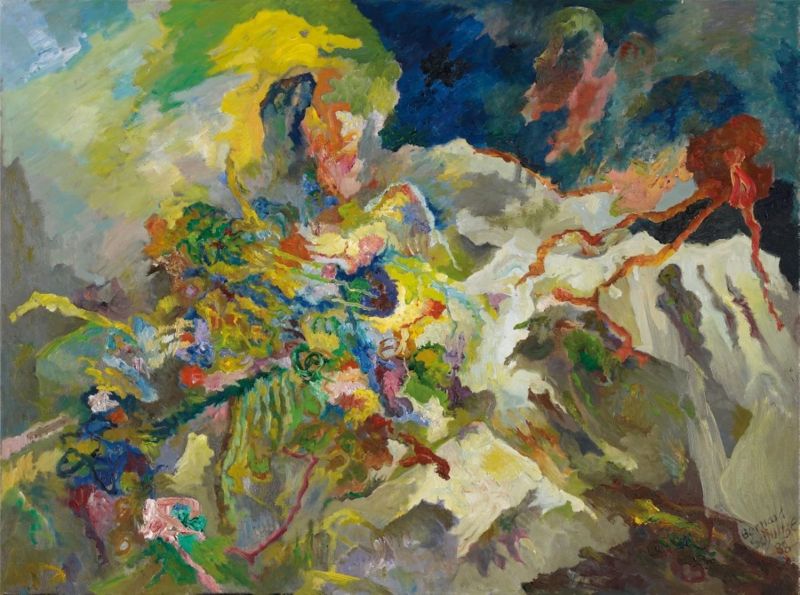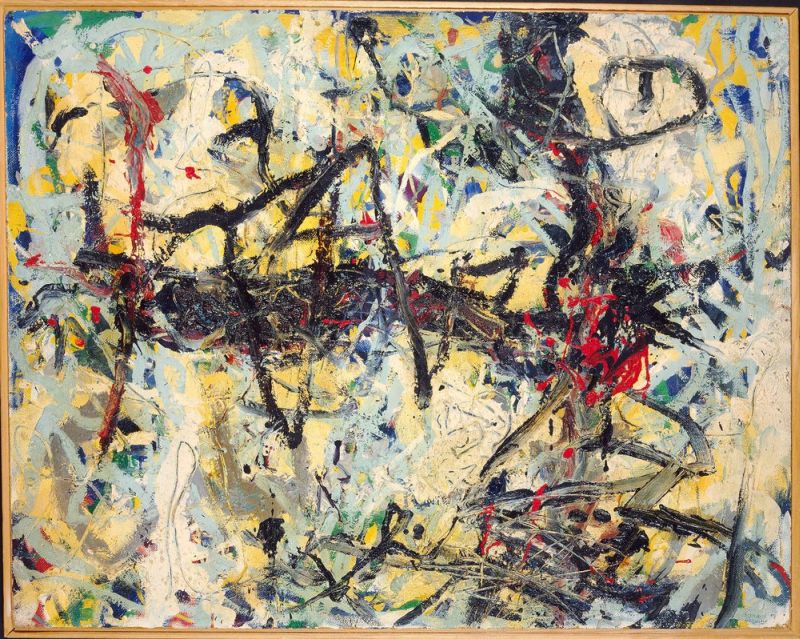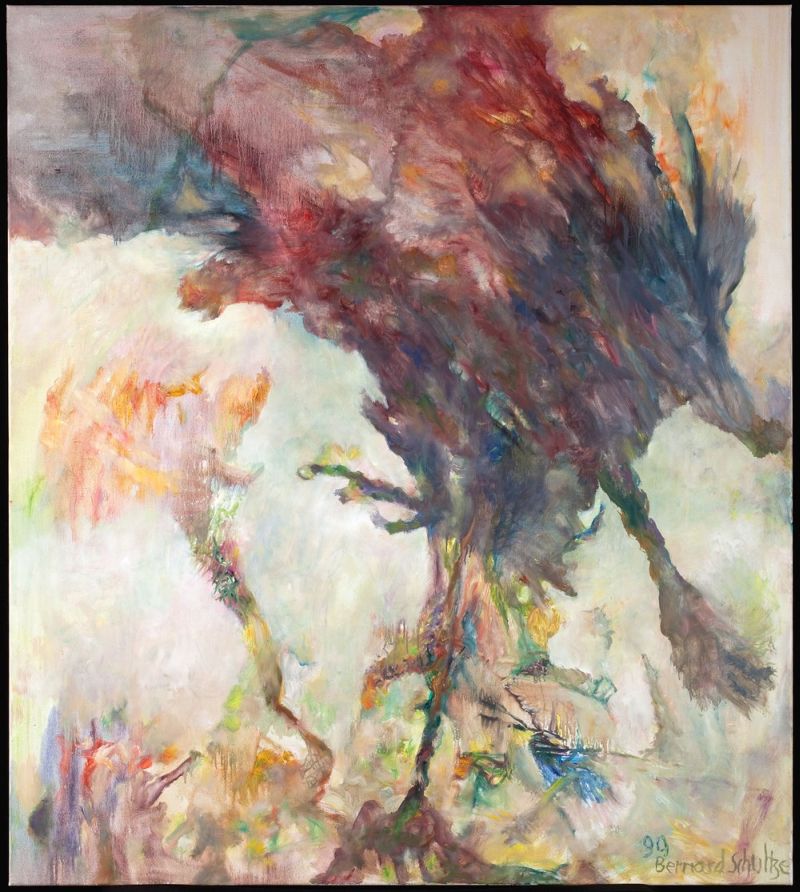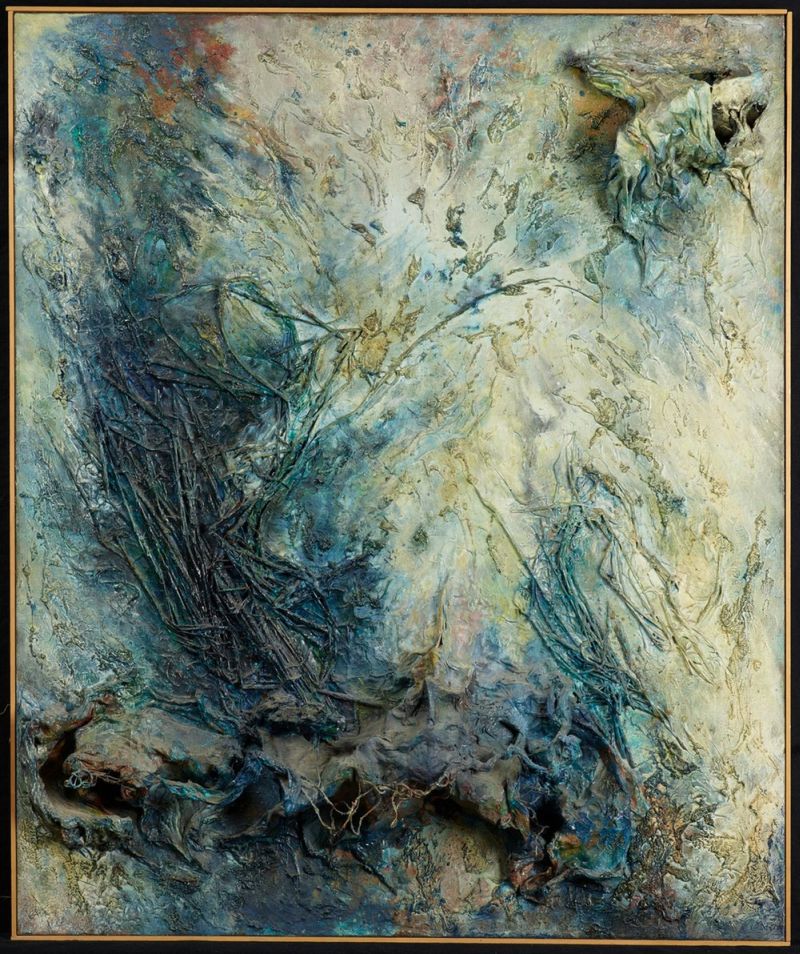_________________________________________________________
El 27 de Mayo es el cumple de
Jessie Hazel Arms Botke, pintora estadounidense nacida en 1883 en Chicago, Illinois, que destacó por sus imágenes de aves y el uso del pan de oro.
Asistió al Chicago Art Institute en 1897-98 y nuevamente de 1902 a 1905. Tomó clases de verano de los artistas John Christen Johansen y Charles Herbert Woodbury, y continuó trabajando con el renombrado Albert Herter, quien tuvo la mayor influencia en la configuración de su enfoque de la composición y el color. Después de un breve viaje a Europa en 1909, regresó a la residencia de sus padres en Chicago y oficialmente registró su profesión como "artista, decoración de interiores".
"Garzas / Egrets"
Óleo y pan de lienzo sobre masonita / oil and gold leaf on masonite, 30" x 25", c.1942. Bonhams
Trabajó como muralista en la ciudad de Nueva York (1911) y en San Francisco (1913-14). Se casó con Cornelius Botke en abril de 1915 y un año después dio a luz a su único hijo, William. Ella y su esposo se mudaron a Carmel-by-the-Sea, California, en 1919 y se convirtieron en figuras influyentes en la colonia de arte local hasta que se mudaron al sur de California en 1927. Durante su carrera fue una expositora prolífica. Fue expositora y secretaria del California Art Club. Regentó el rancho de su familia en Wheeler Canyon, en Santa Paula, mientras seguía pintando.
Murió en 1971.
"Gansos con gloria de la mañana y alceas / Geese with Morning Glories and Hollyhocks"
Óleo sobre masonita / oil on masonite, 32,5" x 40,25", 1932. Bonhams
On May 27 is the birthday of
Jessie Hazel Arms Botke, American painter born in 1883 in Chicago, Illinois, noted for her bird images and use of gold leaf highlights.
She attended the Chicago Art Institute in 1897-98 and again from 1902 to 1905. She took summer classes from artists John Christen Johansen and Charles Herbert Woodbury and continued working with the renowned Albert Herter, who had the most influence in shaping her approach to composition and color. Following a short trip to Europe in 1909, she returned to her parents Chicago residence and officially listed her profession as “artist, interior decorating.”
"Garzas / Egrets"
Óleo sobre lienzo montado sobre panel / oil on canvas laid to board, 40" x 34", c.1930. Bonhams
She worked as a muralist in New York City (1911) and in San Francisco (1913-14). She married Cornelius Botke in April 1915 and gave birth a year later to their only child, William. She and her husband moved to Carmel-by-the-Sea, California in 1919 and became influential figures in the local art colony until they moved to Southern California in 1927. During her career she was a prolific exhibitor. She was an exhibitor and secretary of the California Art Club. She ran her family’s ranch at Wheeler Canyon in Santa Paula, while continuing to paint.
She died in 1971.
Jessie Hazel Arms Botke en "El Hurgador" / in this blog: [Recolección (XCVII)]

El 28 de Mayo es el cumple de
Agustín Reche Mora, pintor hiperrealista español nacido en 1954 en Guadix.
En el contenido de su obra se encuentra latente la pérdida de importancia del presente, lo escurridizo del tiempo y la impotencia del ser humano al no poder controlarlo. Aunque proviene de una tradición pictórica realista academicista, por la forma de reconstruir el espacio sus escaparates nos acercan al mundo de la abstracción.
Si bien se ha podido establecer un orden cronológico que ha situado la totalidad de las obras en tres periodos, las tipologías de los estilos y lenguajes practicados por Reche no participan exactamente de ese mismo orden pues se simultanean en el tiempo.
"Coliseo / Colosseum", óleo sobre tabla / oil on wood, 20 x 40 cm.
Podemos hablar de una etapa de iniciación (1963-1972), autodidacta, con una temática naturalista, con un carácter expresionista. El pintor explora la representación de los diferentes motivos del natural - seres, objetos y sitios- dentro del respeto por las formas y colores locales. Luego una etapa de formación y experimentación (1972 - 1985), en el que las obras naturalistas evolucionan hacia el realismo, expone por primera vez individualmente, y consigue varios premios en concursos de rango nacional. Por último una etapa de consolidación (1986 - 2010), en la que Reche comienza su compromiso como pintor hiperrealista con la obra "Cafetería Windsor" (1986). Al optar por este estilo contemporáneo, consigue expresar aspectos de la realidad, sobre todo a través de motivos urbanos actuales.
A partir de 1979 y hasta 2016, ha impartido clases como profesor en la Facultad de Bellas Artes de Bilbao, ciudad en la que reside desde 1967.
"Bajada de Mallona, Florencia / Descent from Mallona, Florence", óleo / oil, 38 x 46 cm.
Agustín Reche Mora, Spanish hyperrealist painter born in 1954 in Guadix.
In the content of his work lies the loss of importance of the present, the elusiveness of time and the impotence of the human being that he can't control it. Although it comes from a realistic academicist pictorial tradition, by the way of reconstructing the space his shop windows bring us closer to the world of abstraction.
Although it has been possible to establish a chronological order that has placed the totality of the works in three periods, the typologies of the styles and languages practiced by Reche do not participate exactly in the same order because they are simultanean in time.
"Plaza del Ensanche", óleo / oil, 60 x 92 cm., 2008
We can speak of an initiation stage (1963-1972), self-taught, with a naturalistic theme, and an expressionist character. The painter explores the representation of the different natural motifs - beings, objects and places - respecting local shapes and colors. Then a stage of training and experimentation (1972 - 1985), in which naturalist works evolve towards realism, he exposes for the first time individually, and gets several prizes in competitions of national rank. Finally, a stage of consolidation (1986 - 2010), in which Reche begins his commitment as a hyperrealist painter with the work "Cafetería Windsor" (1986). By opting for this contemporary style, he manages to express aspects of reality, especially through current urban motifs.
From 1979 and until 2016, he has taught as a professor at the Faculty of Fine Arts of Bilbao, the city where he has lived since 1967.
"Londres / London, Manchester Square", óleo / oil, 54 x 73 cm.

El 29 de Mayo es el cumple de
Maximino Peña Muñoz, pintor español nacido en 1863 en Salduero, Soria, especialmente dotado para la pintura al pastel con una amplia obra de apuntes, paisajes y temas costumbristas.
En 1876 se trasladó a Argentina a trabajar junto a su tío. Pronto descubrieron sus dotes para la pintura, lo que motivó que comenzara a trabajar con el pintor Blanco Aguirre.
De regreso en la capital de España, ingresó en la Escuela Superior de Pintura, Escultura y Grabado, frecuentando también el Círculo de Bellas Artes de Madrid, donde hizo amistad con Casto Plasencia. En 1885 se instaló en Roma, entrando en el círculo de pintores españoles entre los que estaban Moreno Carbonero, Muñoz Degraín, José Benlliure y Joaquín Sorolla. En 1887, aún en Roma, participó con su cuadro "La carta del hijo ausente" en la Exposición Nacional de Bellas Artes, donde obtuvo una Medalla de Tercera clase. En 1892 volvió a presentarse y consiguió otra Medalla de Tercera clase con el cuadro "Leñador montañes". También lo hizo en 1895, obteniendo la Medalla de Segunda clase con la obra "El bocadillo". En 1901 se le premió por el óleo "Una chula".
"El bebedor / The Drinker", pastel sobre papel pegado en lienzo /
pastel con paper glued on canvas, 76 x 57 cm., 2ª mitad s.XIX / 2nd half 19th century.
Museo Nacional del Prado (Madrid, España / Spain)
De nuevo en Madrid, participó en la decoración de la basílica de San Francisco el Grande, abrió un estudio para la enseñanza del dibujo que sus descendientes ampliaron como "Academia Peña", y llegó a formar parte de la Junta Directiva del Círculo de Bellas Artes. También colaboró como ilustrador en diarios y revistas como "El Imparcial" y "La Ilustración Española y Americana". Además de su obra académica y de uso arquitectónico se ha valorado su dominio de la pintura al pastel y su habilidad en los paisajes del natural, apuntes y fragmentos de la vida cotidiana de estilo costumbrista.
En 1915 presentó una gran exposición en el Salón Iturrioz de Madrid. Expuso por última vez en 1940, año de su muerte, en el Salón Cano de Madrid.
Fue nombrado Caballero de la Orden de Carlos III. En Salduero, su pueblo natal, tiene una casa-museo.
"La carta del hijo ausente / The Letter of the Absent Son", óleo sobre lienzo / oil on canvas, 32 x 21 cm., 1887
Museo Nacional del Prado (Madrid, España / Spain)
On May 29 is the birthday of
Maximino Peña Muñoz, Spanish painter born in 1863 in Salduero, Soria, especially gifted for the pastel painting with a broad body of work of sketches, landscapes and folkloric themes.
In 1876 he moved to Argentina to work with his uncle. They soon discovered his talent for painting, which motivated him to start working with the painter Blanco Aguirre.
Back in the capital of Spain, he entered the School of Painting, Sculpture and Engraving, also frequenting the Círculo de Bellas Artes de Madrid, where he befriended Casto Plasencia. In 1885 he settled in Rome, entering the circle of Spanish painters including Moreno Carbonero, Muñoz Degraín, José Benlliure and Joaquín Sorolla. In 1887, still in Rome, he participated with his painting "The Letter of the Absent Son" in the National Exhibition of Fine Arts, where he obtained a Third Class Medal. In 1892 he did it again obtaining another Third Class Medal with the painting "Mountain woodcutter". He also did it in 1895, obtaining the Second Class Medal with the work "El bocadillo / The Sandwich". In 1901 he was awarded for the oil "Una chula".
"Viejo campesino / Old Peasant", pastel sobre papel / pastel on paper
Revista "La Esfera", año IV, Nº 166, 3/3/1917
Back in Madrid, he participated in the decoration of the basilica of San Francisco el Grande, opened a study for the teaching of drawing that his descendants expanded as "Peña Academy", and became part of the Board of Directors of the Círculo de Bellas Artes. He also collaborated as an illustrator in newspapers and magazines such as "El Imparcial" and "La Ilustración Española y Americana". In addition to his academic work and architectural use, his mastery of pastel painting and his ability in natural landscapes, sketches and fragments of everyday life in the style of manners has been valued.
In 1915 he held a large exhibition at the Iturrioz Hall in Madrid. He exhibited for the last time in 1940, the year of his death, in the Salón Cano in Madrid.
He was named Knight of the Order of Carlos III. In Salduero, his hometown, he has a house-museum.
"Una belleza española / A Spanish Beauty", c.1900. Pinterest

El 30 de Mayo es el cumple de
Gerrit Postma, pintor y copista holandés nacido en 1819 en Nes, Ameland.
Pintó y dibujó retratos, escenas de género y paisajes con figuras. Recibió instrucción de L. A. Kruseman en la academia de Ámsterdam, y más tarde viajó a Italia y España.
Murió en 1894.
"El cuarto de vacunaciones / The Vaccination Room", óleo sobre lienzo / oil on canvas, 94 x 124 cm. Christie's
"El cerdo premiado / The Prize Pig", óleo sobre lienzo / oil on canvas, 73,7 x 100,3 cm. Sotheby's
"En la arena / In the Arena", óleo sobre lienzo / oil on canvas, 83 x 67 cm. Dorotheum
On May 30 is the birthday of
Gerrit Postma, Dutch painter and copyist born in 1819 in Nes, Ameland.
He painted and drew portraits, genre scenes, and landscapes with figures. He was taught by L. A. Kruseman at the Amsterdam academy, and he later travelled to Italy and Spain.
He died in 1894.
Atribuido / Attributed
"Familia española en la fuente / Spanish Family At the Well"Óleo sobre lienzo / oil on canvas, 85 x 60 cm., 1861. Bidsquare
"El párroco del pueblo / The Village Priest"
Óleo sobre lienzo / oil on canvas, 31,5 x 44,5 cm. Lotsearch

El 31 de Mayo es el cumple de
Bernard Schultze, pintor alemán nacido en 1915 en Schneidemühl, hoy Piła, Polonia. Fue un destacado exponente de la pintura abstracta gestual en Europa. En 1952 fundó el grupo de artistas Quadriga con Karl Otto Götz y otros, anunciando el arte informal en Alemania. Al inicio de su carrera adoptó la opinión de André Breton de que los procesos creativos deberían guiarse por el inconsciente. Continuó desarrollando un vocabulario visual intensamente personal que reveló un compromiso con una amplia gama de fenómenos históricos del arte y lo estableció como una presencia distintiva en la pintura y el dibujo.
Los Migof jugaron un papel importante en esto, proliferando misteriosamente coloridas formas que se asemejan a criaturas vivas que a veces pueblan sus imágenes expresivas, pero profundamente asociativas. En sus últimos años, hasta su muerte, en abril de 2005, registró sistemáticamente reacciones en cadena en el proceso de pintura para producir obras únicas, a menudo en una escala monumental.
"Salvator rosa eingedenk / En recuerdo de Salvator Rosa / In Remembrance of Salvator Rosa"
Óleo sobre lienzo / oil on canvas, 90 x 120 cm, 1988. Lempertz
Salvator Rosa en "El Hurgador" / in this blog: [Aniversarios (LXXV)]
Schultze nació el 31 de mayo de 1915. El Museo Ludwig, que alberga una gran parte de su patrimonio artístico, le rindió homenaje en el centenario de su nacimiento con una exposición de obras de su propia colección, expuesta en tres galerías. Junto con una serie de primeros dibujos y pinturas, la exposición se centró en las últimas dos décadas de la carrera del artista. La ocasión también estuvo marcada por la publicación por Hirmer Verlag de un catálogo razonado de sus pinturas y esculturas.
Schultze residió en Colonia desde 1968 hasta su muerte, en 2005. Durante décadas él y su esposa artista, Úrsula, quien murió en 1999, fueron figuras destacadas en la vida cultural de la ciudad. Sus obras inconfundibles, con sus invenciones formales a menudo inusuales, estuvieron y están representadas en exposiciones y colecciones de museos en Alemania y el extranjero.
"Insektenhaft", témpera oleosa sobre panel / oil tempera on hardboard, 72 x 94 cm., 1952
© Museum Ludwig, VG Bild-Kunst Bonn, 2015, Foto / Photo: Rheinisches Bildarchiv, Köln
"Leibhaftig / Encarnado / Incarnate", óleo sobre lienzo / oil on canvas, 140 x 120 cm. Bidtoart
On May 31 is the birthday of
Bernard Schultze, German painter born in 1915 in Schneidemühl, now Piła, Poland. He was a leading exponent of gestural abstract painting in Europe. In 1952 he founded the artists’ group Quadriga with Karl Otto Götz and others, ushering in Art Informel in Germany. Early in his career he adopted André Breton’s view that creative processes should be guided by the unconscious. He went on to develop an intensely personal visual vocabulary that revealed an engagement with a wide range of art historical phenomena and established him as a distinctive pressence in painting and drawing.
An important part in this was played by the Migofs, mysteriously proliferating colored forms resembling living creatures that some times populate his expressive, yet deeply associative images. In his later years, right up to his death, in April 2005, he consistently recorded chain reactions in the painting process to produce uniquely compelling works, of ten on a monumental scale.
"Der Sturm-Migof / La tormenta Migof / The Migof Storm"
Óleo sobre lienzo / oil on canvas, 160 x 140 cm., 1999
© Museum Ludwig, VG Bild-Kunst Bonn, 2015, Foto: Rheinisches Bildarchiv, Köln
Schultze was born on 31 May 1915. The Museum Ludwig, which houses a large part of his artistic estate, payed homage to him on the centennial of his birth with an exhibition of works from its own collection, displayed in three galleries. Along with a number of early drawings and paintings, the exhibition focused on the last two decades of the artist’s career. The occasion was also marked by the publication by Hirmer Verlag of a catalogue raisonné of his paintings and sculptures.
Schultze was based in Cologne from 1968 until his death, in 2005. For decades he and his artist wife, Ursula, who died in 1999, were prominent figures in the cultural life of the city. His unmistakable works, with their of ten unusual formal inventions, were and are represented in exhibitions and museum collections in Germany and abroad.
The Museum Kunst palast in Düsseldorf is show ing Bernard Schultze (1915–2005): Works from the Kemp Collection until August 30, 2015.
"Rifrost / Arrecife / Reef", óleo y elementos plásticos sobre lienzo /
oil and plastic elements on canvas, 120 x 100 x 32 cm., 1958
© Museum Ludwig, VG Bild-Kunst Bonn, 2015, Foto / Photo: Rheinisches Bildarchiv, Köln






















